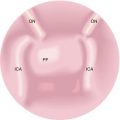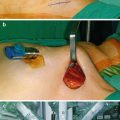Royal College of Pathologists-modified BTA nomenclature
US Bethesda System (BSRTC)
Risk of malignancy (%)
Thy1: Nondiagnostic
I: Nondiagnostic
0–10
Virtually acellular specimen
Other (blood, clotting artifacts, etc.)
Thy1c: Nondiagnostic – cystic lesion
Cyst fluid only
Thy2: Nonneoplastic
II: Benign
0–3
Consistent with a benign follicular nodule or lymphocytic thyroiditis or granulomatous (subacute) thyroiditis
Thy2c: Nonneoplastic, cystic lesion
Thy3a: Neoplasm possible – atypia
III: Atypia of undetermined significance (AUS) or follicular lesion of undetermined significance (FLUS)
5–15
Thy3f: Neoplasm possible – suggestive of follicular neoplasm
IV: Follicular neoplasm or suspicious for follicular neoplasm
15–30
Specify if Hürthle cell (oncocytic) type
Thy4: Suspicious of malignancy
V: Suspicious for malignancy
60–75
Suspicious for papillary/medullary/metastatic/lymphoma
Carcinoma
Thy5: Malignant
VI: Malignant
97–100
Risk Factors of Malignancy
Although FNAC of thyroid nodules represent the most sensitive and specific test for malignancy, additional assessment of other risk factors would further improve the diagnostic rate of thyroid nodules. Efforts to further improve the management of these patients with indeterminate FNAC results have focused on identifying clinical, sonographic, and more recently molecular characteristics that predict malignancy.
Clinical Risk Factors
Clinical variables have been investigated for a long time with regard to their ability to predict malignancy. High-risk history/examination features such as hoarseness, fixation of thyroid nodule to adjacent structures, nodal disease, strong family history or genetic conditions (e.g., medullary thyroid carcinoma, Cowden’s syndrome), and prior radiation exposure are well known but are relatively uncommon findings. Other major clinical factors that have been investigated are age, gender, and tumor size (Fiore et al. 2009):
Age: Generally high risk if less than 20 or older than 70.
Gender: Although females are 2–3 times more likely to suffer a thyroid cancer, nodule in a male is associated with 1.5–2-fold increased risk compared with a female.
Tumor size: This feature is the least consistently found to be a risk factor determinator. Some studies have shown tumors larger than 3–4 cm more likely to be malignant.
Serum TSH: Significantly higher levels of TSH are present in patients who are subsequently diagnosed with thyroid cancer, suggesting it could be used as an adjunct to FNAC (Fiore et al. 2009).
Sonographic Risk Factors
There have been advances in associating sonographic features of thyroid nodules to malignancy risk. Hypoechogenicity, solid composition, microcalcifications, irregular or ill-defined margins, an absent sonolucent rim (or “halo”), and Doppler evidence of increased blood flow in the center of the nodule are associated with an increased risk of malignancy (Alexander 2008). True microcalcification appears to be the highest predictor of malignancy. Of course associated abnormal lymph nodes are highly suspicious for a primary thyroid malignancy.
Molecular Risk Factors
Much effort has been made to identify molecular markers of thyroid malignancy. The most widely studied and most promising markers are BRAF, RAS, PAX8-PPAR-g, Galectin-3, and RET-PTC rearrangements. Recent research has shown in particular, BRAF mutational analysis to enhance diagnostic accuracy when used in conjunction with FNAC (Nikiforov and Nikiforova 2011). Several large centers in the USA now routinely test all thyroid FNAC samples for BRAF mutation as positivity provides both diagnostic and prognostic information. Further, in the USA (and perhaps shortly in Europe), there is increasing use of the commercial “genetic” testing Afirma (Veracyte Inc: http://www.veracyte.com/afirma/) on indeterminate FNAC samples that appears to be very accurate. This panel of tests is presently very expensive but with eventual drop in costs its use may become widespread and points towards the expected future of molecular/gene testing in routine clinical practice.
Stay updated, free articles. Join our Telegram channel

Full access? Get Clinical Tree





